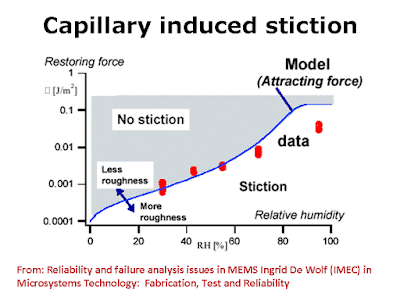30th August 2016
Back to Singapore.
 |
| Traditional Malay Style House in Geylang. Probably the last of its kind. |
 |
| Colourful Shophouse |
 |
| 99 Red Lanterns? |
One of the big challenges in MEMS is how to dice the wafers. Unlike conventional IC
wafers:
• MEMS may contain minute and
extremely delicate structures such as cantilevers, bridges, hinges, gears,
membranes and other sensitive features that necessitate special handling and
care.
•
MEMS may contain membranes, high aspect-ratio
topography and other pressure-sensitive components that cannot withstand the
impact of water encountered during dicing and the subsequent cleaning cycle,
and raise the need for a protective mechanism to shield them from the constant
flow of liquid.
•
MEMS often have moving parts that are super sensitive
to contamination, and in which the presence of tiny debris particles may hinder
or even halt movement altogether.
•
Some MEMS (e.g. electrostatic actuators) are highly sensitive to ESD
phenomena and may fail upon spontaneous electrostatic discharges.
 |
| MEMS Dicing Challenges From: Stealth Dicing for MEMS, Hammamatsu |
 |
| Dicing damage to MEMS membranes From Stealth Dicing for MEMS, Hammamatsu |
Dicing Options
- Temporary
protective layer on wafer before dicing, dice and remove protective layer
- Scribe
and break
- Stealth
dicing
- Cap
before dicing
Considering each in turn:
1. Temporary protective
layer
•
Temporary protective sacrificial layer covers the MEMS
wafer during dicing step and cleaning
•
Later removed or washed away
•
Usually polymer film
•
Remove by dry (plasma) or wet techniques.
2. Scribe and Break
- There are commercial systems for this eg Dynatex StreetSmart™ Breaker
- Applies controlled amount of stress localized to the partial saw cut one street at a time
- As stress is applied, the remaining silicon directly below the partial saw cut breaks
 |
| Scribe and Break Schematic |
3. Stealth dicing
4 Cap before dicing
- Individual caps or capping
- wafer placed over the MEMS wafer
- Caps or capping wafer can be attached by adhesive, solder, or anodic bonding methods
- Conventional dicing can then be applied
 |
| Cap before Dicing |































